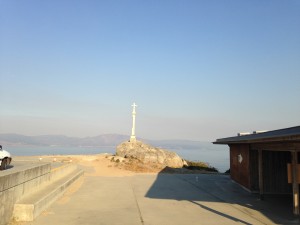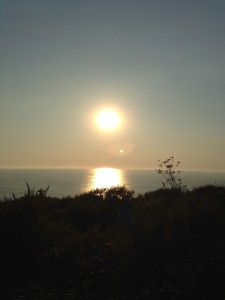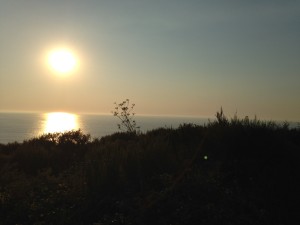Santiago de Compostela to Finisterre
Day 30, Sunday 22 September 2013
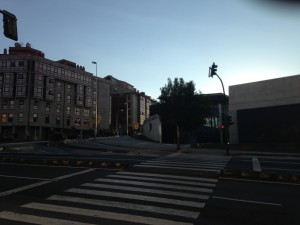
On Sunday 22 September 2013 we took the bus to Finisterre. Many pilgrims, who finished the walk to Santiago, continued walking the 90 km to Finisterre. We considered walking to Finisterre but 30 km per day for three days did not appeal to me. Therefore we took the bus. The route to Finisterre was scenic, going through villages, forests and part of it was next to the sea. It was a two and half hour drive by bus from Santiago. We were delayed for half hour because of an accident on the motorway and we witnessed the landing of a helicopter offloading medical personnel and provisions.
Finisterre is a small fishing town and medieval beliefs were that this was the end of the world. Finis Terra means end of the world. A tradition that still exists today and handed down through medieval pilgrim reports concerned the burning of clothes worn on the pilgrimage. The ritual demanded that you burn your clothes, that you bathe in the sea, and watch the sunset, so that you awake the next day a new person.
We arrived at Finisterre also Fistera and booked in at hotel Ancora. After we had unpacked, we decided that since we were hungry to go out for lunch. We hoped that we would find an open restaurant because it was that time of the day, siesta. We were lucky and had a wonderful meal at O Centolo.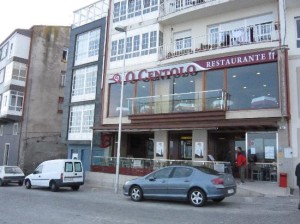
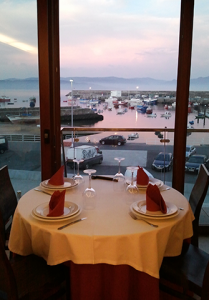
We ordered a vegetarian risotto, had good wine, excellent views and celebrating the end of our journey. The Camino de Santiago redefined us by pushing our limits, challenging our beliefs and learning about ourselves.
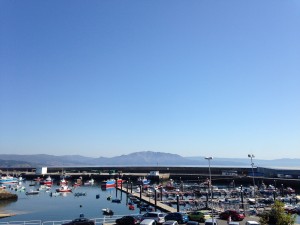
After lunch we walked to the beach where we had a lovely walk and could not get enough of the tranquil view of the sea.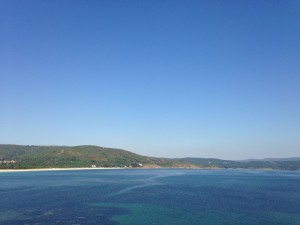
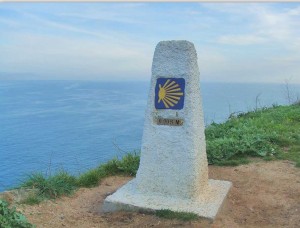
We walked back to our hotel and decided to walk up to the lighthouse that was, according to the hotel website, a 3-minute walk. Surprise! It was at least 4 km walk uphill, on a narrow road with deep cliffs and no proper pathways for pedestrians but with amazing views of the sea. We walk along the edge of the Atlantic up a mountain that is known as Monte Facho. This is where many medieval pilgrims came to get closure after their long journey to the tomb of the apostle Saint James in Santiago de Compostela. Faro de Fisterra was one of the most important landmarks in Galicia. The lighthouse was built in 1853 and can be seen on a clear day from 30 kilometres at sea. The northwest coastline of Galicia is aptly named Costa da Morte, the Coast of Death. The coastline is rough, jagged and treacherous. Numerous ships were lying on the floor of the Atlantic, with many more lives lost. It is not only pleasure and fishing boats that run into trouble, but well-documented naval battles between the French and English took place just off Cape Fisterra.
In the area there were many pre-Christian sacred locations. There was an “Altar Soli” on Cape Finisterre where the Celts came to practice their cult to the sun and the ocean, and shared in their devotion of stones. Many stones became the bearers of a secret language, containing various inscriptions and religious icons that have been hollowed out with time. San Guillerme, also known as St. William of Penacorada, lived in a house located on Monte Facho which was near a stone known as “St William’s Stone” (Pedra de San Guillerme) where sterile couples tried to conceive, following a Celtic rite of fertility. Many more rocks around Fisterra and the Costa da Morte are considered by the locals to have curative powers. Christians would later build on Celtic and Roman tradition, sculpting large pieces of granite into crosses (known as cruceiros), and placing them along the sides of roads and shrines to bless travellers on their journey.
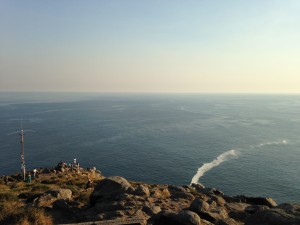 We reached the lighthouse at the top of Monte Facho and walked down to the “end of the world”. Gazing out from the pinnacle of rock into the vast ocean I felt a sense of empathy with those who thought the world ended at that dissecting horizon.
We reached the lighthouse at the top of Monte Facho and walked down to the “end of the world”. Gazing out from the pinnacle of rock into the vast ocean I felt a sense of empathy with those who thought the world ended at that dissecting horizon.
At the crucerio at the end of the world pilgrims place stones, on this and similar crosses along the Camino de Santiago for many reasons. Sometimes, they include notes on paper or cloth, in memory of their journey and the lessons learned, or a letting go of the past and a look forward to a new beginning. It could be a note to themselves; a promise to keep, a memory of a loved one, or a repenting of a sin. Maybe they are saying goodbye to someone and ready to greet someone new. Whatever the reason, it is personal and meaningful. I put the last of the soil from Raymond’s grave on a suitable place at a beautiful out-of-the-way spot. I felt consolation by leaving the last of the soil there with was carried all the way along the Camino. Marinda left her walking stick there as symbol of reaching the end of the way.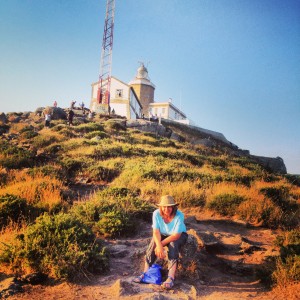
We did not burn our clothes or swam naked in the sea but wanted to watch the sun until it disappeared in the sea. We unfortunately also could not do this because we had to walk back in the dark on the narrow road.
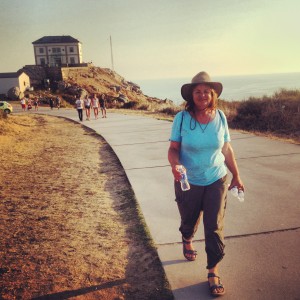
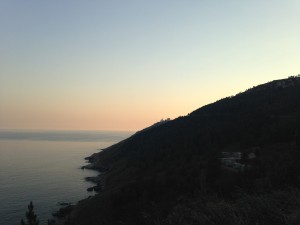
When walking back to the hotel we were able to observe the sunset and the lighthouse in the distance.
I did not walk from a religious perspective and the Cathedral in Santiago and the probability of a dead saint in the tomb did not contribute to the closure I wanted. The ocean, the setting, the vibe and again, nature as God’s cathedral, which always had open doors, was more consolation. This was indeed a spiritual location. Standing at the end of the world amid a symphony of rock, sun, blue sky and wave I was able to understand why this place was so exceptional, God’s creation.

